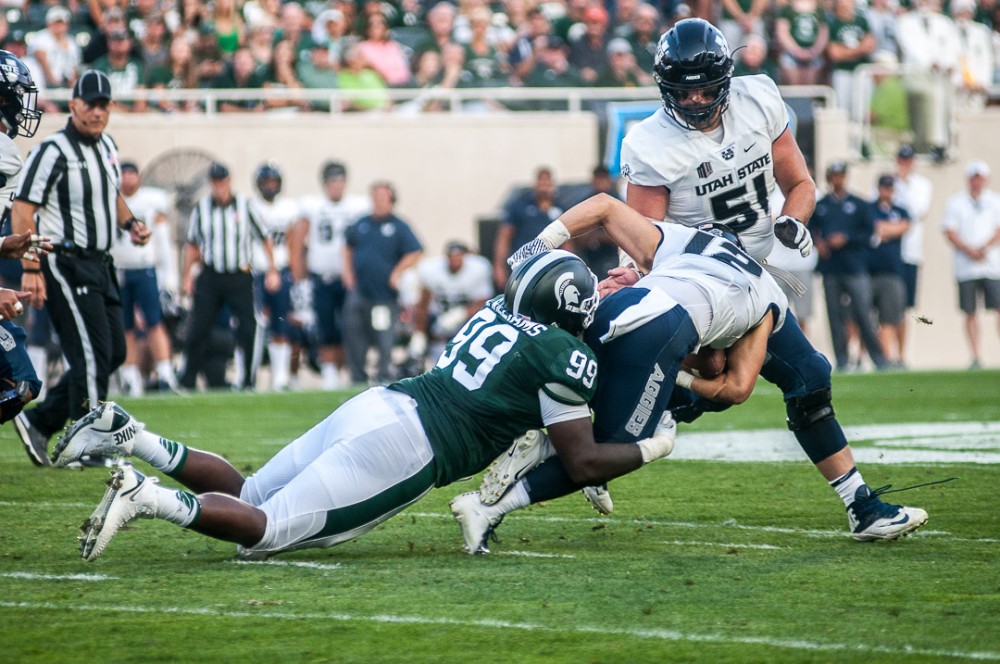USU vs. Michigan State: By the Numbers
Aggie football is FINALLY back, and so is my weekly “By the Numbers” column. In this
week’s edition, I’m going to look at some of the most important statistics from Utah
State’s 31-38 near-upset of No. 11 Michigan State.
25 – Number of rushing yards Utah State earned
Last season, there were 875 college football games played at the FBS level. Of those
875 games, exactly two of them were won by teams who had 25 rushing yards or less.
Yet, somehow, Utah State didn’t get completely blown out of the water in this game.
Now, before you get too down on USU’s run game, you should understand how good
Michigan State’s run defense is. Last season, they held three different P5 opponents to
25 rushing yards or less. They also held all but two opponents to 116 rushing yards or
less. That’s ridiculous. While I don’t think that fully dismisses the poor running
performance by the Aggies, it certainly makes it a little bit more understandable. Junior
running back Darwin Thompson accounted for 28 of Utah State’s 25 total net rushing
yards. Yeah, that’s right. He had 28 yards, while the rest of the team combined for -3.
The Aggies did, however, do a nice job of punching the ball into the endzone, putting
three rushing touchdown on a defense which only allowed 12 last season.
10 – The number of Aggie players who had a catch vs the Spartans
While, as I noted, Utah State’s rushing offense suffered in this game, it’s hard for Aggie
fans to not get excited about what the offense was able to do through the air. Last
season, there were just four games in which 10 or more USU players caught passes
(three of those were blowout wins), and this game was just the second time Jordan Love
was able to find 10 different receivers in a game. What that tells me, is that even though
the Aggies were facing one of the toughest defenses in the nation, Love felt comfortable
enough in the pocket to be able to read the defense, move through his progressions and
make the right throw. 65% of the time, to be exact. One of the worst kept secrets of the
summer was the ridiculous depth Utah State has at the receiver and tight end positions,
and Love did an excellent job of showcasing that to the nation on Friday night.
3:37 – Average USU time of possession on scoring drives
I’ve seen and heard some people talking about how badly the Aggies got killed in the
“time of possession battle,” which I think is silly. Yes, Michigan State possessed the ball
for 37:44 to Utah State’s 22:16. However, that’s not entirely a negative thing. The Aggies
showed that they are very capable of moving the ball quickly, effectively, and efficiently
when they need to. Matt Wells made it very clear heading into this game that his team
would use an up-tempo, fast-paced offense to try to catch Michigan State off guard, and
there was no better example of that than the seven play, 75-yard touchdown drive to
begin the game which only took just over two minutes. Of course establishing a solid
running game will help keep the ball out of their opponents hands, but if the offense is as
efficient and the defense is as good as what we saw on Friday night, time of possession
is the last thing for this team to worry about.
3.9 – Allowed rushing yards per attempt
Remember how one of the major concerns about this Aggie team coming into the
season was how well they would be able to stop the run? The USU defense doesn’t.
After ranking 115th in the nation in total rush defense a season ago, the Aggie defense
marched into East Lansing and had a pretty respectable day stopping the run. Now,
holding an opponent to 3.9 yards per rushing attempt isn’t groundbreaking, it truly isn’t
even all that special. But when you consider the competition USU was facing, how badly
they struggled to stop the run last season, and the fact that last year’s leading tackler
Suli Tamaivena wasn’t even on the field, it was a pretty solid showing. Oh, that’s not
even to mention the two ridiculous goal line stands where the Spartans had first-and-
goal inside the USU three-yard line and were held to a field goal.
—
jadencrockettjohnson@gmail.com
Twitter: @jadenjohnson00

